Work and Organisations: The Changing Nature of the Workplace
VerifiedAdded on 2019/10/30
|7
|1349
|160
Essay
AI Summary
This essay delves into the significant transformations occurring in today's workplaces, contrasting them with the more stable environments of the 1990s. It explores how factors such as technological advancements, the rise of team-based work, and the emphasis on cognitive and social skills are reshaping the nature of work. The essay examines key drivers of these changes, including the lean enterprise model and the proliferation of mobile technologies, and their impact on both employees and management. It discusses the challenges workers face, such as cognitive and social skill gaps, and provides recommendations for managers to navigate the uncertain future, including fostering continuous learning, promoting employee development, and adapting to technological changes. The essay concludes by emphasizing the need for both workers and organizations to develop cognitive and social competencies to thrive in the evolving workplace.
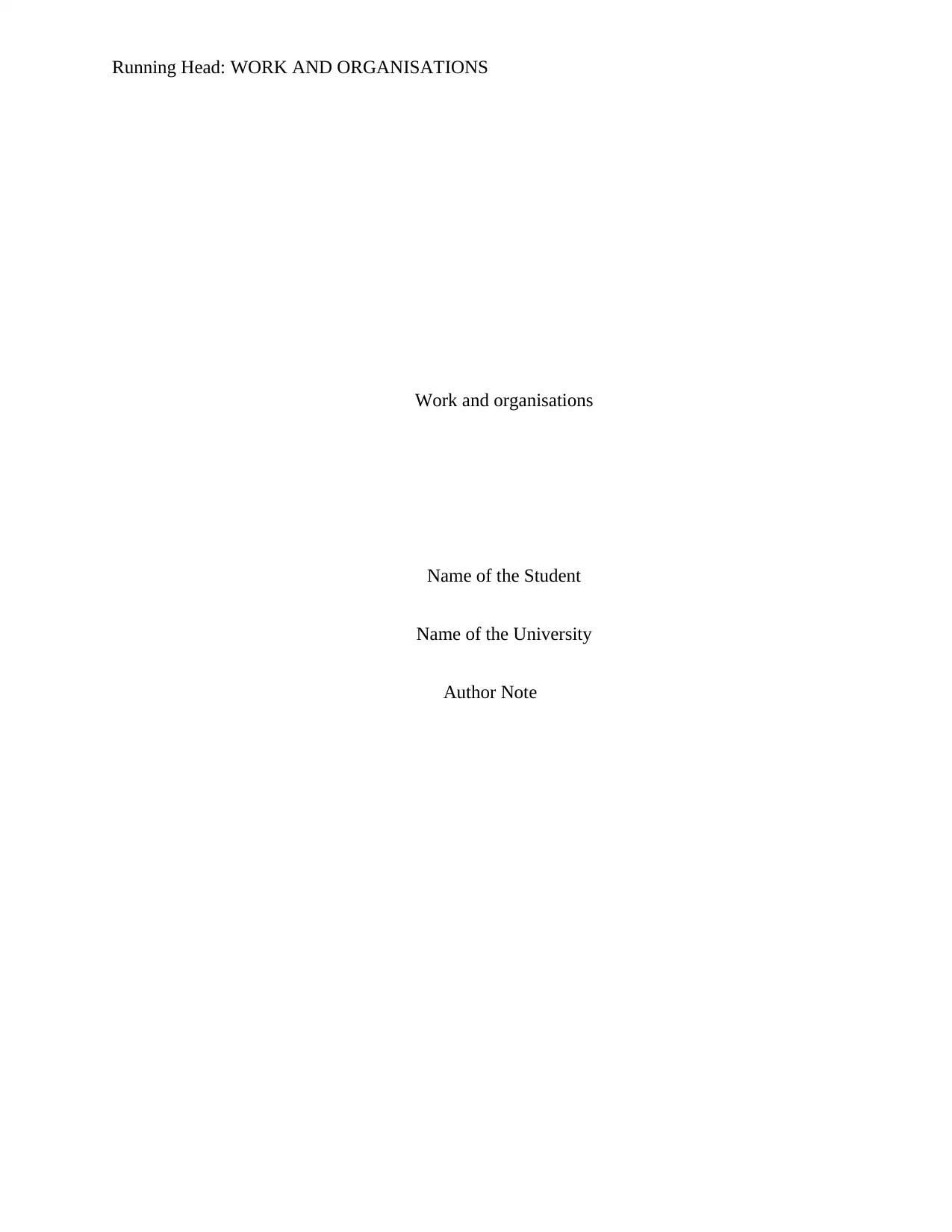
Running Head: WORK AND ORGANISATIONS
Work and organisations
Name of the Student
Name of the University
Author Note
Work and organisations
Name of the Student
Name of the University
Author Note
Paraphrase This Document
Need a fresh take? Get an instant paraphrase of this document with our AI Paraphraser
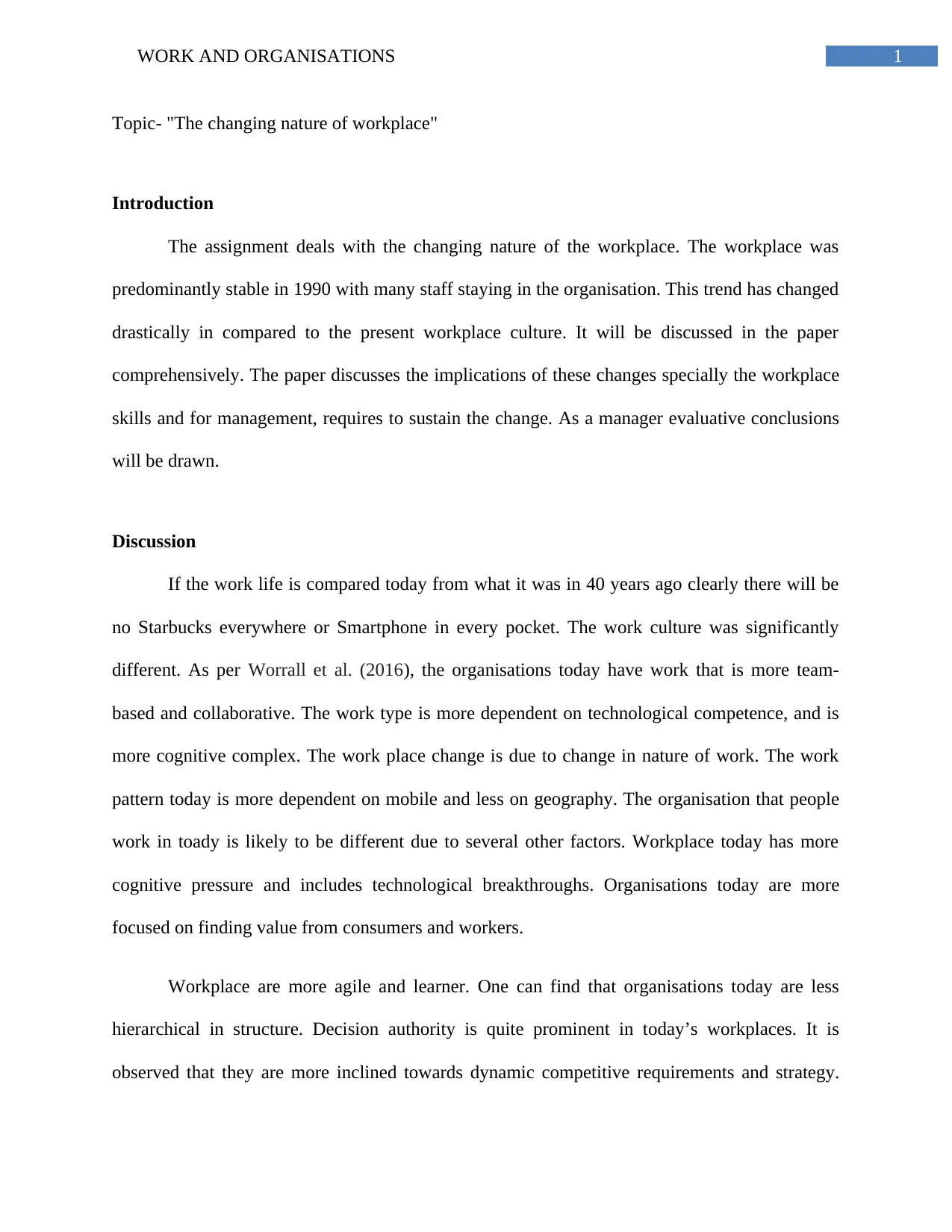
1WORK AND ORGANISATIONS
Topic- "The changing nature of workplace"
Introduction
The assignment deals with the changing nature of the workplace. The workplace was
predominantly stable in 1990 with many staff staying in the organisation. This trend has changed
drastically in compared to the present workplace culture. It will be discussed in the paper
comprehensively. The paper discusses the implications of these changes specially the workplace
skills and for management, requires to sustain the change. As a manager evaluative conclusions
will be drawn.
Discussion
If the work life is compared today from what it was in 40 years ago clearly there will be
no Starbucks everywhere or Smartphone in every pocket. The work culture was significantly
different. As per Worrall et al. (2016), the organisations today have work that is more team-
based and collaborative. The work type is more dependent on technological competence, and is
more cognitive complex. The work place change is due to change in nature of work. The work
pattern today is more dependent on mobile and less on geography. The organisation that people
work in toady is likely to be different due to several other factors. Workplace today has more
cognitive pressure and includes technological breakthroughs. Organisations today are more
focused on finding value from consumers and workers.
Workplace are more agile and learner. One can find that organisations today are less
hierarchical in structure. Decision authority is quite prominent in today’s workplaces. It is
observed that they are more inclined towards dynamic competitive requirements and strategy.
Topic- "The changing nature of workplace"
Introduction
The assignment deals with the changing nature of the workplace. The workplace was
predominantly stable in 1990 with many staff staying in the organisation. This trend has changed
drastically in compared to the present workplace culture. It will be discussed in the paper
comprehensively. The paper discusses the implications of these changes specially the workplace
skills and for management, requires to sustain the change. As a manager evaluative conclusions
will be drawn.
Discussion
If the work life is compared today from what it was in 40 years ago clearly there will be
no Starbucks everywhere or Smartphone in every pocket. The work culture was significantly
different. As per Worrall et al. (2016), the organisations today have work that is more team-
based and collaborative. The work type is more dependent on technological competence, and is
more cognitive complex. The work place change is due to change in nature of work. The work
pattern today is more dependent on mobile and less on geography. The organisation that people
work in toady is likely to be different due to several other factors. Workplace today has more
cognitive pressure and includes technological breakthroughs. Organisations today are more
focused on finding value from consumers and workers.
Workplace are more agile and learner. One can find that organisations today are less
hierarchical in structure. Decision authority is quite prominent in today’s workplaces. It is
observed that they are more inclined towards dynamic competitive requirements and strategy.
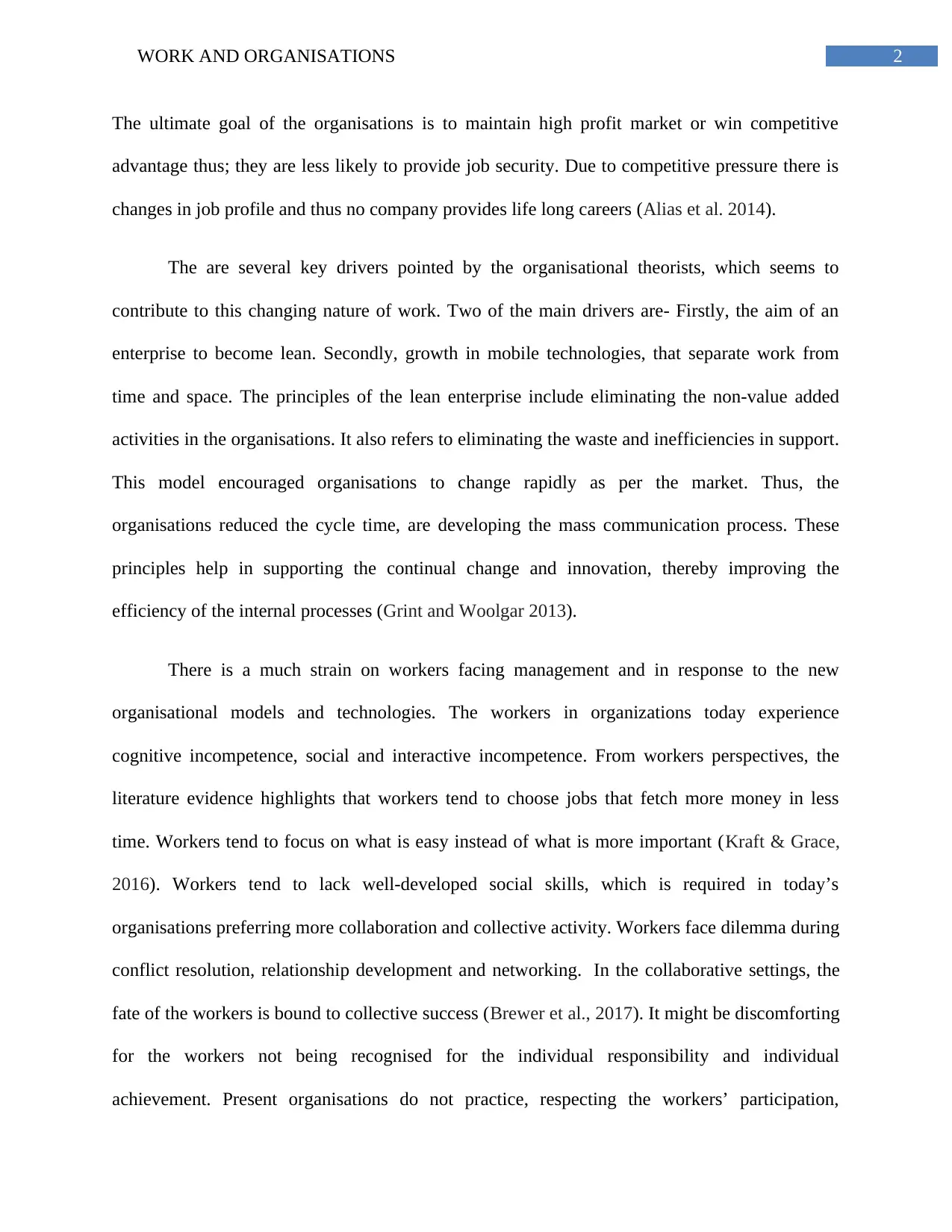
2WORK AND ORGANISATIONS
The ultimate goal of the organisations is to maintain high profit market or win competitive
advantage thus; they are less likely to provide job security. Due to competitive pressure there is
changes in job profile and thus no company provides life long careers (Alias et al. 2014).
The are several key drivers pointed by the organisational theorists, which seems to
contribute to this changing nature of work. Two of the main drivers are- Firstly, the aim of an
enterprise to become lean. Secondly, growth in mobile technologies, that separate work from
time and space. The principles of the lean enterprise include eliminating the non-value added
activities in the organisations. It also refers to eliminating the waste and inefficiencies in support.
This model encouraged organisations to change rapidly as per the market. Thus, the
organisations reduced the cycle time, are developing the mass communication process. These
principles help in supporting the continual change and innovation, thereby improving the
efficiency of the internal processes (Grint and Woolgar 2013).
There is a much strain on workers facing management and in response to the new
organisational models and technologies. The workers in organizations today experience
cognitive incompetence, social and interactive incompetence. From workers perspectives, the
literature evidence highlights that workers tend to choose jobs that fetch more money in less
time. Workers tend to focus on what is easy instead of what is more important (Kraft & Grace,
2016). Workers tend to lack well-developed social skills, which is required in today’s
organisations preferring more collaboration and collective activity. Workers face dilemma during
conflict resolution, relationship development and networking. In the collaborative settings, the
fate of the workers is bound to collective success (Brewer et al., 2017). It might be discomforting
for the workers not being recognised for the individual responsibility and individual
achievement. Present organisations do not practice, respecting the workers’ participation,
The ultimate goal of the organisations is to maintain high profit market or win competitive
advantage thus; they are less likely to provide job security. Due to competitive pressure there is
changes in job profile and thus no company provides life long careers (Alias et al. 2014).
The are several key drivers pointed by the organisational theorists, which seems to
contribute to this changing nature of work. Two of the main drivers are- Firstly, the aim of an
enterprise to become lean. Secondly, growth in mobile technologies, that separate work from
time and space. The principles of the lean enterprise include eliminating the non-value added
activities in the organisations. It also refers to eliminating the waste and inefficiencies in support.
This model encouraged organisations to change rapidly as per the market. Thus, the
organisations reduced the cycle time, are developing the mass communication process. These
principles help in supporting the continual change and innovation, thereby improving the
efficiency of the internal processes (Grint and Woolgar 2013).
There is a much strain on workers facing management and in response to the new
organisational models and technologies. The workers in organizations today experience
cognitive incompetence, social and interactive incompetence. From workers perspectives, the
literature evidence highlights that workers tend to choose jobs that fetch more money in less
time. Workers tend to focus on what is easy instead of what is more important (Kraft & Grace,
2016). Workers tend to lack well-developed social skills, which is required in today’s
organisations preferring more collaboration and collective activity. Workers face dilemma during
conflict resolution, relationship development and networking. In the collaborative settings, the
fate of the workers is bound to collective success (Brewer et al., 2017). It might be discomforting
for the workers not being recognised for the individual responsibility and individual
achievement. Present organisations do not practice, respecting the workers’ participation,
⊘ This is a preview!⊘
Do you want full access?
Subscribe today to unlock all pages.

Trusted by 1+ million students worldwide
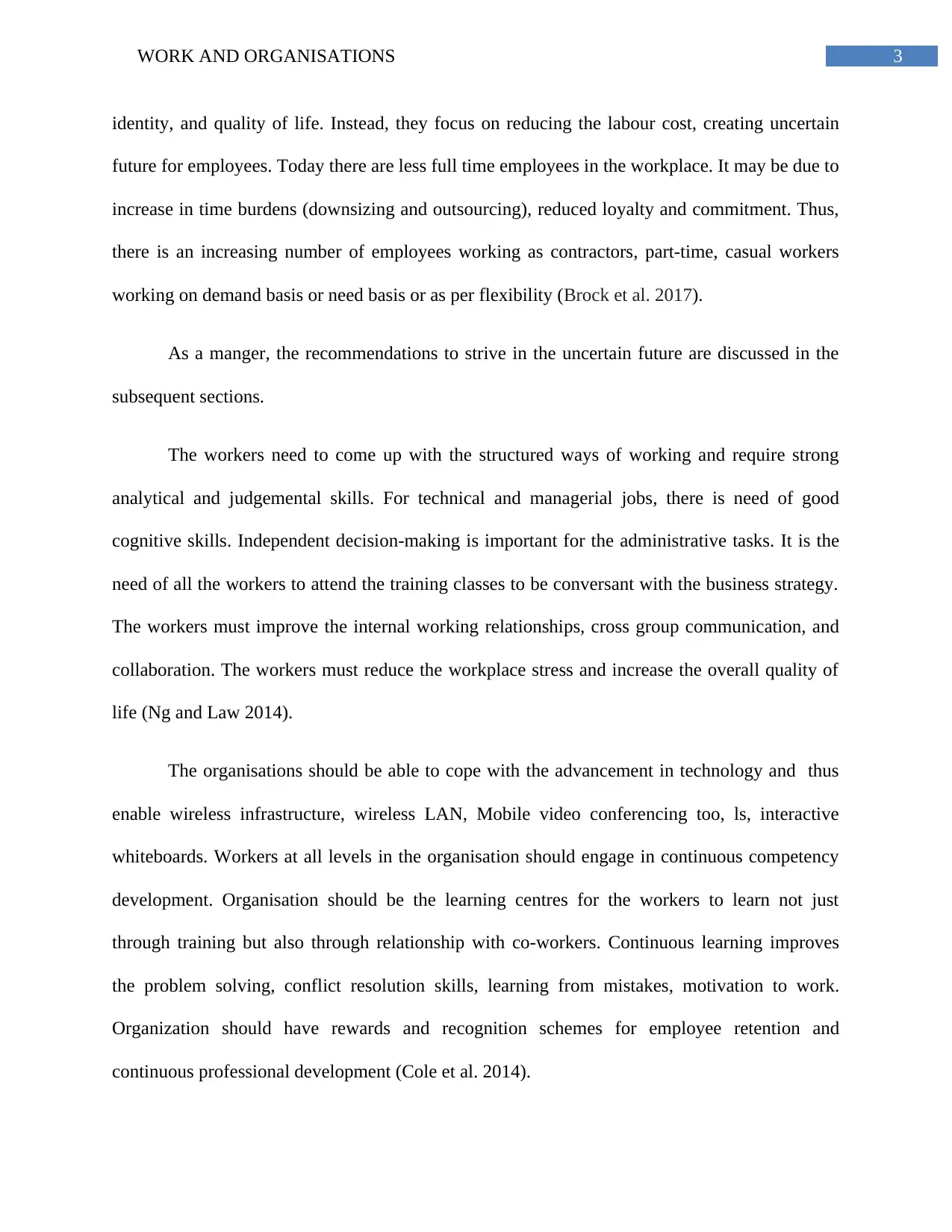
3WORK AND ORGANISATIONS
identity, and quality of life. Instead, they focus on reducing the labour cost, creating uncertain
future for employees. Today there are less full time employees in the workplace. It may be due to
increase in time burdens (downsizing and outsourcing), reduced loyalty and commitment. Thus,
there is an increasing number of employees working as contractors, part-time, casual workers
working on demand basis or need basis or as per flexibility (Brock et al. 2017).
As a manger, the recommendations to strive in the uncertain future are discussed in the
subsequent sections.
The workers need to come up with the structured ways of working and require strong
analytical and judgemental skills. For technical and managerial jobs, there is need of good
cognitive skills. Independent decision-making is important for the administrative tasks. It is the
need of all the workers to attend the training classes to be conversant with the business strategy.
The workers must improve the internal working relationships, cross group communication, and
collaboration. The workers must reduce the workplace stress and increase the overall quality of
life (Ng and Law 2014).
The organisations should be able to cope with the advancement in technology and thus
enable wireless infrastructure, wireless LAN, Mobile video conferencing too, ls, interactive
whiteboards. Workers at all levels in the organisation should engage in continuous competency
development. Organisation should be the learning centres for the workers to learn not just
through training but also through relationship with co-workers. Continuous learning improves
the problem solving, conflict resolution skills, learning from mistakes, motivation to work.
Organization should have rewards and recognition schemes for employee retention and
continuous professional development (Cole et al. 2014).
identity, and quality of life. Instead, they focus on reducing the labour cost, creating uncertain
future for employees. Today there are less full time employees in the workplace. It may be due to
increase in time burdens (downsizing and outsourcing), reduced loyalty and commitment. Thus,
there is an increasing number of employees working as contractors, part-time, casual workers
working on demand basis or need basis or as per flexibility (Brock et al. 2017).
As a manger, the recommendations to strive in the uncertain future are discussed in the
subsequent sections.
The workers need to come up with the structured ways of working and require strong
analytical and judgemental skills. For technical and managerial jobs, there is need of good
cognitive skills. Independent decision-making is important for the administrative tasks. It is the
need of all the workers to attend the training classes to be conversant with the business strategy.
The workers must improve the internal working relationships, cross group communication, and
collaboration. The workers must reduce the workplace stress and increase the overall quality of
life (Ng and Law 2014).
The organisations should be able to cope with the advancement in technology and thus
enable wireless infrastructure, wireless LAN, Mobile video conferencing too, ls, interactive
whiteboards. Workers at all levels in the organisation should engage in continuous competency
development. Organisation should be the learning centres for the workers to learn not just
through training but also through relationship with co-workers. Continuous learning improves
the problem solving, conflict resolution skills, learning from mistakes, motivation to work.
Organization should have rewards and recognition schemes for employee retention and
continuous professional development (Cole et al. 2014).
Paraphrase This Document
Need a fresh take? Get an instant paraphrase of this document with our AI Paraphraser
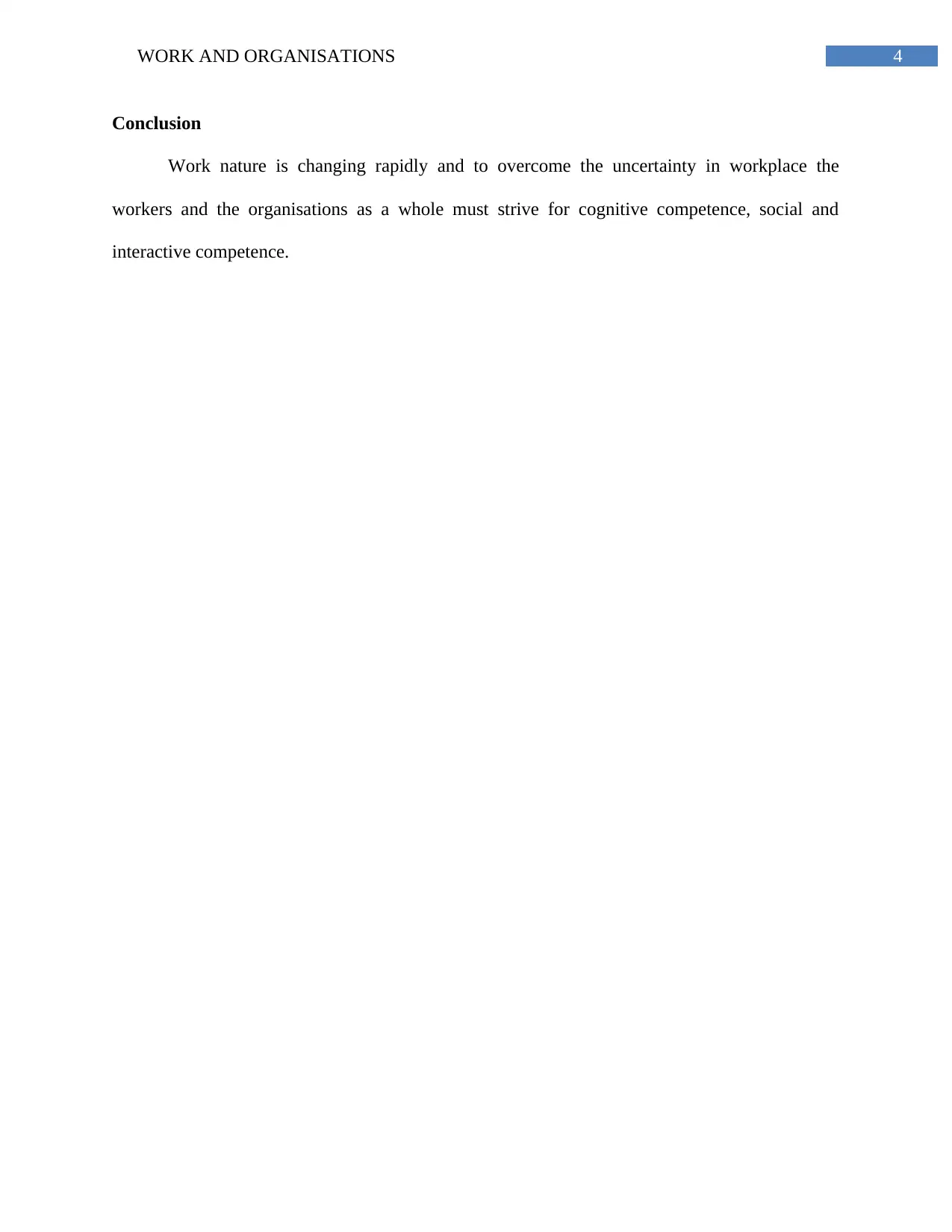
4WORK AND ORGANISATIONS
Conclusion
Work nature is changing rapidly and to overcome the uncertainty in workplace the
workers and the organisations as a whole must strive for cognitive competence, social and
interactive competence.
Conclusion
Work nature is changing rapidly and to overcome the uncertainty in workplace the
workers and the organisations as a whole must strive for cognitive competence, social and
interactive competence.
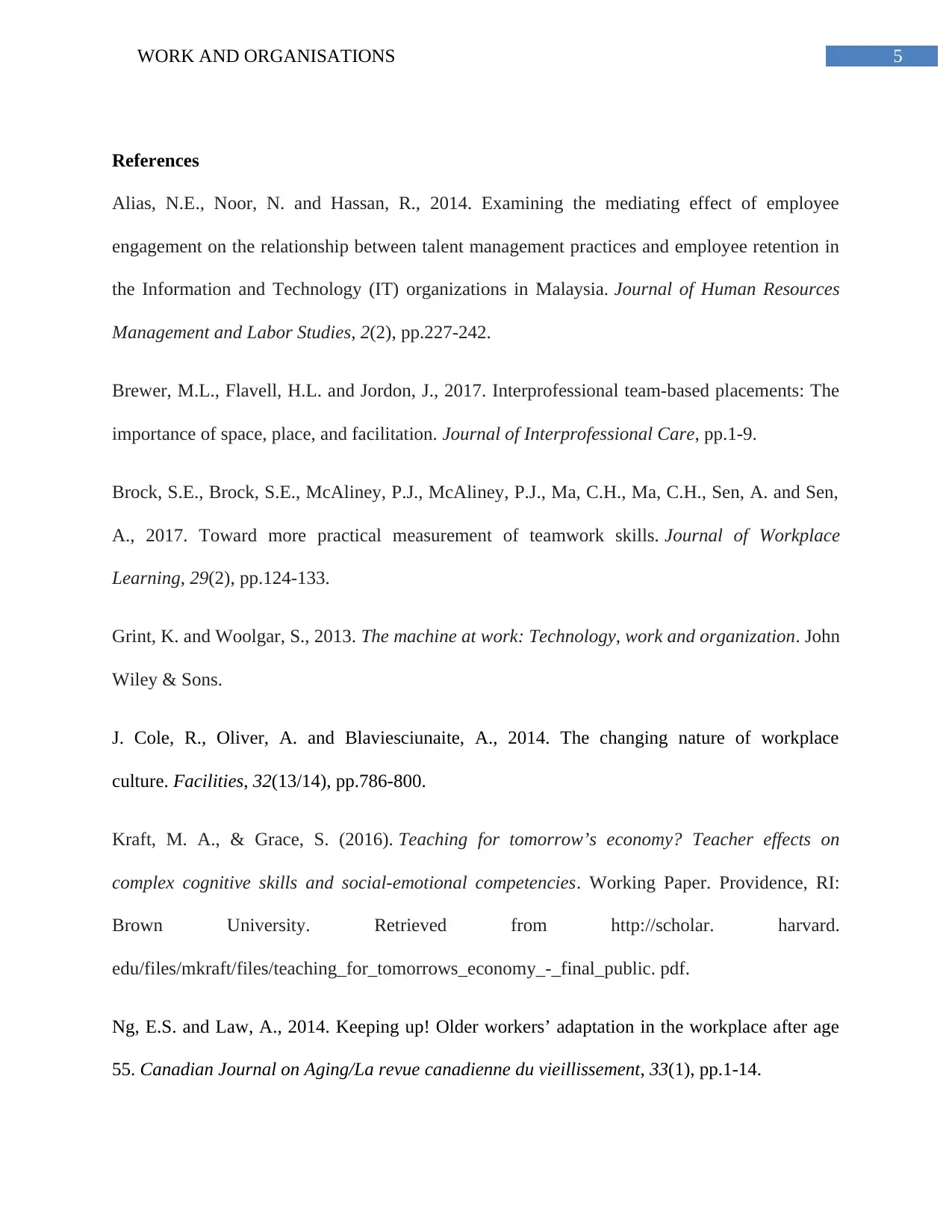
5WORK AND ORGANISATIONS
References
Alias, N.E., Noor, N. and Hassan, R., 2014. Examining the mediating effect of employee
engagement on the relationship between talent management practices and employee retention in
the Information and Technology (IT) organizations in Malaysia. Journal of Human Resources
Management and Labor Studies, 2(2), pp.227-242.
Brewer, M.L., Flavell, H.L. and Jordon, J., 2017. Interprofessional team-based placements: The
importance of space, place, and facilitation. Journal of Interprofessional Care, pp.1-9.
Brock, S.E., Brock, S.E., McAliney, P.J., McAliney, P.J., Ma, C.H., Ma, C.H., Sen, A. and Sen,
A., 2017. Toward more practical measurement of teamwork skills. Journal of Workplace
Learning, 29(2), pp.124-133.
Grint, K. and Woolgar, S., 2013. The machine at work: Technology, work and organization. John
Wiley & Sons.
J. Cole, R., Oliver, A. and Blaviesciunaite, A., 2014. The changing nature of workplace
culture. Facilities, 32(13/14), pp.786-800.
Kraft, M. A., & Grace, S. (2016). Teaching for tomorrow’s economy? Teacher effects on
complex cognitive skills and social-emotional competencies. Working Paper. Providence, RI:
Brown University. Retrieved from http://scholar. harvard.
edu/files/mkraft/files/teaching_for_tomorrows_economy_-_final_public. pdf.
Ng, E.S. and Law, A., 2014. Keeping up! Older workers’ adaptation in the workplace after age
55. Canadian Journal on Aging/La revue canadienne du vieillissement, 33(1), pp.1-14.
References
Alias, N.E., Noor, N. and Hassan, R., 2014. Examining the mediating effect of employee
engagement on the relationship between talent management practices and employee retention in
the Information and Technology (IT) organizations in Malaysia. Journal of Human Resources
Management and Labor Studies, 2(2), pp.227-242.
Brewer, M.L., Flavell, H.L. and Jordon, J., 2017. Interprofessional team-based placements: The
importance of space, place, and facilitation. Journal of Interprofessional Care, pp.1-9.
Brock, S.E., Brock, S.E., McAliney, P.J., McAliney, P.J., Ma, C.H., Ma, C.H., Sen, A. and Sen,
A., 2017. Toward more practical measurement of teamwork skills. Journal of Workplace
Learning, 29(2), pp.124-133.
Grint, K. and Woolgar, S., 2013. The machine at work: Technology, work and organization. John
Wiley & Sons.
J. Cole, R., Oliver, A. and Blaviesciunaite, A., 2014. The changing nature of workplace
culture. Facilities, 32(13/14), pp.786-800.
Kraft, M. A., & Grace, S. (2016). Teaching for tomorrow’s economy? Teacher effects on
complex cognitive skills and social-emotional competencies. Working Paper. Providence, RI:
Brown University. Retrieved from http://scholar. harvard.
edu/files/mkraft/files/teaching_for_tomorrows_economy_-_final_public. pdf.
Ng, E.S. and Law, A., 2014. Keeping up! Older workers’ adaptation in the workplace after age
55. Canadian Journal on Aging/La revue canadienne du vieillissement, 33(1), pp.1-14.
⊘ This is a preview!⊘
Do you want full access?
Subscribe today to unlock all pages.

Trusted by 1+ million students worldwide
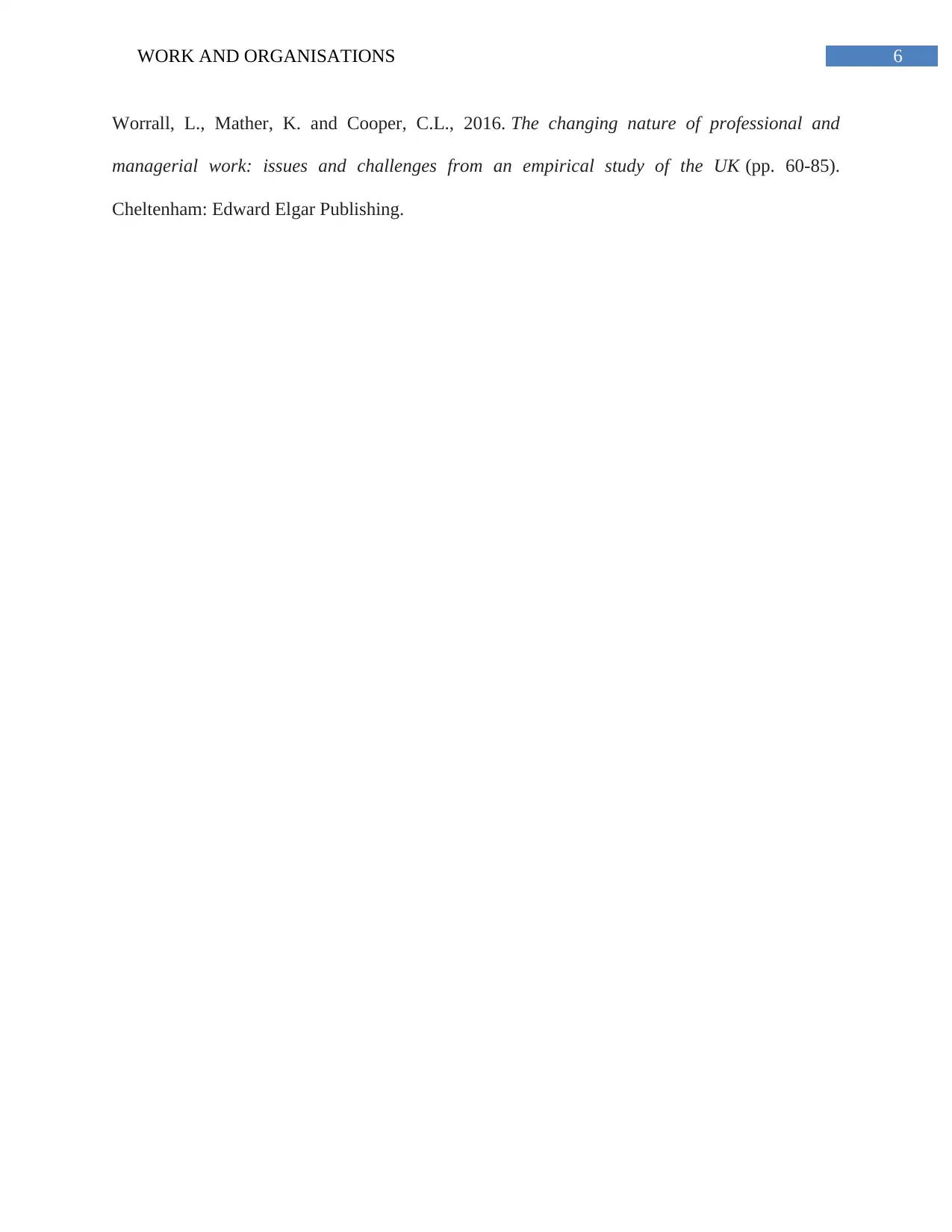
6WORK AND ORGANISATIONS
Worrall, L., Mather, K. and Cooper, C.L., 2016. The changing nature of professional and
managerial work: issues and challenges from an empirical study of the UK (pp. 60-85).
Cheltenham: Edward Elgar Publishing.
Worrall, L., Mather, K. and Cooper, C.L., 2016. The changing nature of professional and
managerial work: issues and challenges from an empirical study of the UK (pp. 60-85).
Cheltenham: Edward Elgar Publishing.
1 out of 7
Related Documents
Your All-in-One AI-Powered Toolkit for Academic Success.
+13062052269
info@desklib.com
Available 24*7 on WhatsApp / Email
![[object Object]](/_next/static/media/star-bottom.7253800d.svg)
Unlock your academic potential
Copyright © 2020–2025 A2Z Services. All Rights Reserved. Developed and managed by ZUCOL.




